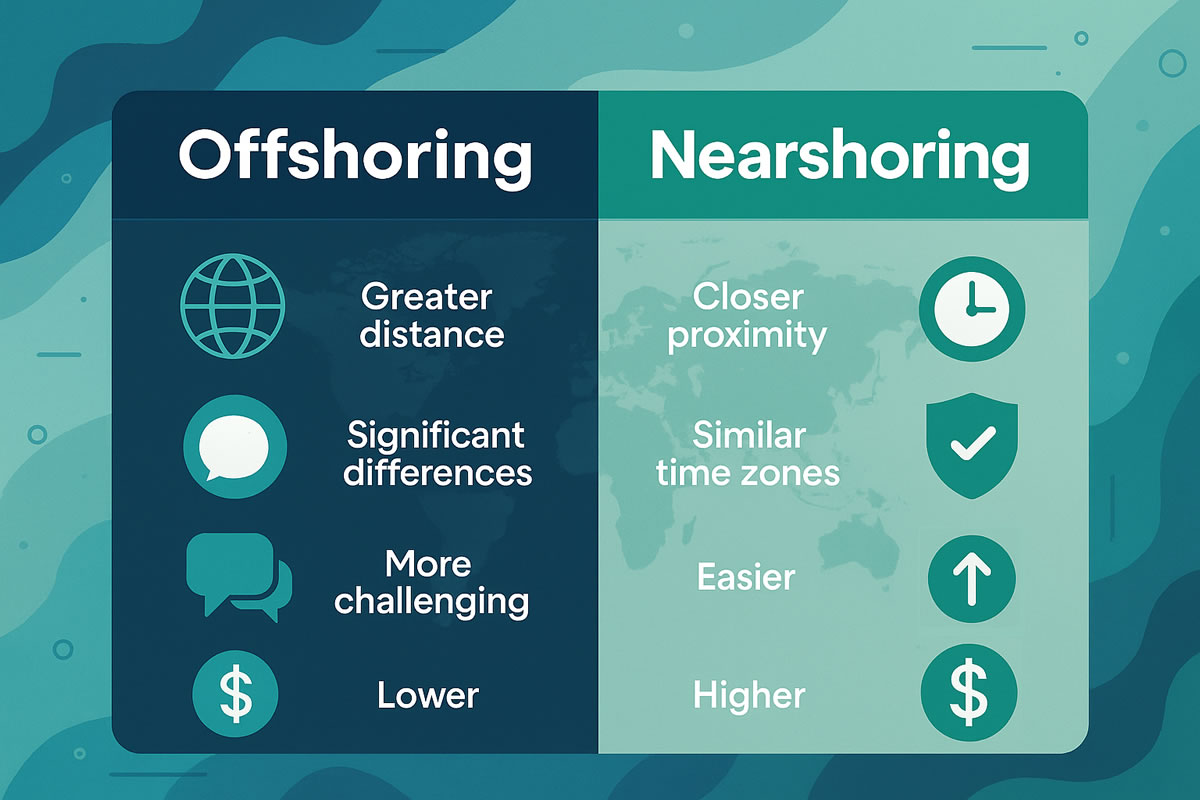Understanding Offshoring and Nearshoring
Offshoring and nearshoring both involve outsourcing software development tasks to external vendors, but they differ primarily in geographical proximity and, consequently, in operational dynamics.
- Offshoring refers to contracting software engineering work to teams located in distant countries, often in different continents. For example, a U.S.-based company might offshore development to India, Ukraine, or the Philippines.
- Nearshoring involves delegating software development to companies in neighboring or nearby countries with closer time zones and cultural affinities. For example, a company in the U.S. might nearshore software development to Argentina, Mexico, or other parts of Latin America.
Key Differences
| Aspect | Offshoring | Nearshoring |
|---|---|---|
| Geography | Far-flung locations, often intercontinental | Neighboring or nearby countries, shared region |
| Time Zone Overlap | Less time zone overlap; often significant differences | Greater time zone alignment for easier collaboration |
| Cultural Affinity | Often more cultural differences | Higher cultural and language similarities |
| Cost Efficiency | Typically lower labor costs | Slightly higher costs but still cost-effective |
| Communication | Communication challenges due to language and time zone gaps | Easier real-time communication and collaboration |
| Quality of Work | Varied depending on vendor; sometimes concerns about standards | High-quality work due to closer oversight and cultural alignment |
| Speed to Market | May experience delays due to coordination challenges | Faster iteration cycles support quicker releases |
| Risk Factors | Higher risks related to political, legal, and IP issues | Reduced risks, easier legal frameworks and IP protection |
Why the Differences Matter for Your Business
Cost Considerations
Offshoring often promises substantial cost savings because of lower average wages in certain far-away countries. According to Deloitte’s 2023 Global Outsourcing Survey, companies offshore primarily to reduce operational costs. However, significant hidden costs arise from managing communication delays, quality controls, and cultural misunderstandings—sometimes eroding anticipated savings.
Nearshoring tends to have moderately higher hourly rates but can reduce project overruns and rework, improving overall ROI. For example, North American businesses outsourcing to Latin America reported 20-30% faster project turnaround times compared to offshoring across continents.
Communication and Collaboration
Software development demands continuous, clear communication. Offshoring can be hindered by time zone differences exceeding 10 hours and linguistic or cultural barriers, complicating synchronous meetings and agile workflows. Nearshoring vendors typically operate within 1-3 time zones and often share linguistic or cultural traits, facilitating daily collaboration and quick resolution of impediments.
DevWise, with nearshore teams in strategically located countries, leverages this proximity to maintain transparent and frequent communication—key in agile software delivery.
Quality and Control
Maintaining software quality and IP security can be complex when dealing with distant offshore vendors. Differences in legal systems and enforcement mechanisms may expose businesses to risks. Nearshoring partners often work under similar or compatible legal frameworks, easing contract management and intellectual property protections.
Moreover, closer proximity allows more frequent in-person visits, audits, and hands-on project management—boosting quality assurance.
Speed and Flexibility
Nearshoring enables faster and more flexible development cycles because overlapping working hours allow for quicker iterations and feedback loops. This is especially valuable for enterprises operating in fast-moving markets where time-to-market is critical.
When to Choose Offshoring vs. Nearshoring
Offshoring Is Best When:
- Your primary goal is to maximize cost savings on large, less time-sensitive software projects.
- You can manage projects asynchronously with mature remote communication tools.
- Your business can accept higher risks related to coordination and IP protections.
- You have experience handling offshore partnerships or dedicated teams for oversight.
Nearshoring Is Best When:
- You prioritize closer collaboration, cultural alignment, and real-time communication.
- You require agile development with rapid iteration and frequent feedback.
- You want to mitigate risks related to IP, quality, or political uncertainty.
- Your projects demand flexibility to adapt quickly to changing requirements.
DevWise’s Nearshore Advantage
DevWise partners with forward-looking businesses seeking high-impact software solutions with nearshored teams across Latin America. A leading fintech company recently engaged DevWise to enhance its mobile banking platform. By nearshoring, they realized:
- 25% reduction in development cycle time due to same-day collaboration
- 40% fewer communication misunderstandings as teams shared similar cultural contexts
- Improved quality and faster bug resolution with weekly in-person and virtual reviews
The outcome was a successful product release ahead of schedule, with enhanced user satisfaction and a lower total cost of ownership compared to previous offshore efforts.
Conclusion
Aligning Your Outsourcing Strategy with Business Objectives
Choosing between offshoring and nearshoring in software engineering is not merely a cost calculation but a strategic decision influenced by communication needs, risk tolerance, time-to-market requirements, and quality expectations.
- Offshoring offers attractive cost benefits but may demand rigorous management of communication and quality risks.
- Nearshoring provides closer collaboration, faster responsiveness, and reduced operational risks—often at a slightly higher, yet more predictable cost.
DevWise helps businesses navigate this decision by offering tailored nearshore software engineering teams that integrate seamlessly with your internal resources, ensuring agility and transparency.
Next Steps:
- Assess your project needs: Determine your priorities—are speed, quality, and communication more important, or is cost the overriding factor?
- Evaluate vendors’ geographical and cultural fit: Consider the impact of time zones and cultural alignment on collaboration.
- Engage with trusted partners: Explore development firms with proven nearshore capabilities like DevWise.
- Pilot small projects: Start with a manageable project to test communication workflows and quality standards.
- Invest in clear communication protocols and contract governance: Maximize your outsourcing success by developing strong processes.
By carefully weighing the pros and cons and partnering wisely, IT and business leaders can harness outsourcing strategies that accelerate innovation and deliver lasting business value.
For more insights on optimizing software development strategies, contact our expert consultants for a personalized assessment.







